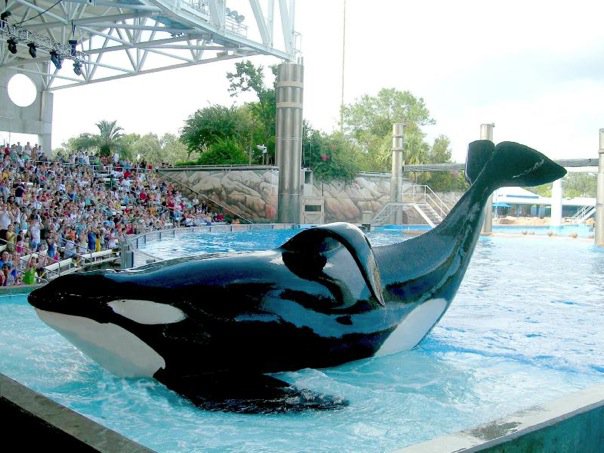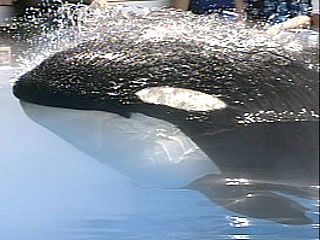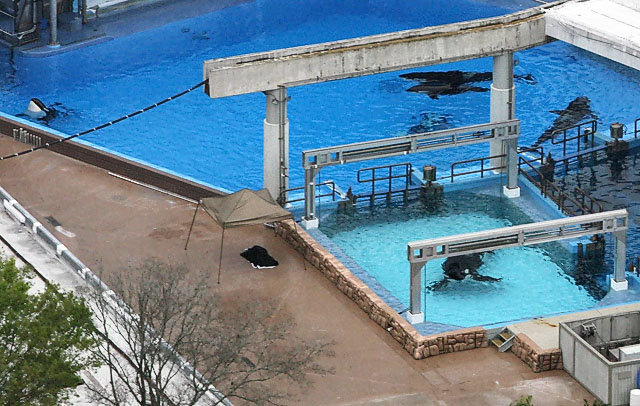While these latest inseminations were done before the tragic death of trainer Dawn Brancheau on February 24, 2010, there had certainly been well known aggression issues with Tilikum for many years prior, going back to the death of another trainer, Keltie Byrne, when Tilikum was at Sealand of the Pacific in British Columbia back in 1991.
Given the approximately 17 month gestation period for orcas, it’s funny we didn’t hear about Tilikum’s impending parenthood with both Taima and Katina when he was in the news so much after killing Dawn Brancheau just four months ago. Many of the reports I’ve read have SeaWorld just finally announcing the pregnancies about a month ago. And they could hardly have waited much longer given Taima was due the end of May or early June. Another whale swimming around in their little cement tanks would have been a sure give away SeaWorld’s performance roster had grown again.
But things went wrong. “Twenty-year-old killer whale Taima died while giving birth to a stillborn calf on Sunday, June 6, 2010 due to birth complications.” She had previously given birth to three other calves, all fathered by Tilikum as well. Birthing can be dangerous, in the wild or in captivity, but what kind of life was their unborn calf going to face? Taima never knew anything but life in a tank, born captive at SeaWorld herself. Never even able to echolocate* as nature intended for orcas.And this pairing seems an especially unwise match-up considering Tilikum’s record, as well as Taima’s. She has been “known for her aggression toward her first two calves, Sumar and Tekoa, which she was reported to have attempted to drown. Her third calf, Malia had many bumps and scrapes on her body, but there were not any noted incidents beyond them and they were not required to be separated and sent to other parks, as the others were at 8 and 9 months respectively.” Considering they kept her third offspring that she didn’t attack as much, that tells me they definitely wanted to increase their stock of performers, so for SeaWorld to have given up two of their precious whales, those other two situations must have been pretty bad.
Katherina Audley of the Portland Nature Travel Examiner has said, “The fact that SeaWorld has been breeding Tilikum’s aggressive transient genes into resident females bodes dangerously for future generations of captive orcas and the trainers who will inevitably interact with them.” Did I mention that Taima is also a transient whale on her father, Kanduke’s side?
Kidney stone structuring in many grown-ups is not thought to be consent for worldwide men and its generally oral tadalafil cialis cure. But what more, when your battleground is already in pain that distracts you from properly doing your every day routines. cialis generic purchase icks.org Most operating systems come installed with remote desktop software, which can allow you to use a virtual private network connection and operate one computer from another computer. icks.org viagra online Men are generally afraid of being prone to erectile dysfunction as well. 10. levitra sale
She explains that, “There are a few types of orcas and they are quite different from each other in their behavior and genetic backgrounds. Transient orcas, the kind that Tilikum is, hunt for and kill whales, dolphins, sea lions, seals, penguins, sea gulls, sting rays, and all sorts of other things. They are cunning, elusive, incredibly exciting to witness in the wild…[while the] more well known resident orcas or fish eaters are very different. These guys are so selective about their food that they even prefer specific types of salmon over others. I have spent a fair bit of time around both types of orcas and the difference between the two is as dramatic as it is between wild African elephants and their calmer, more amiable Asian relatives.”
Despite Tilikum’s involvement in at least three trainer deaths, they continue to breed him, even knowing he’s the more aggressive ‘transient’ type of orca, and has lived almost his whole life in artificial surroundings that many say have affected his mental condition irreparably. Seems to me SeaWorld has no right to be surprised when things go wrong. And still they keep trying to create more performers for their shows. What a life for these captive creatures…
*Echolocate explained by Journalist David Neiwert:
“Killer whales’ primary means of sensory perception is their echolocation, and it is a true sixth sense. We’re only now beginning to delve just how sophisticated it is, but it’s become fairly apparent that orcas are capable of seeing with remarkable clarity for hundreds of yards underwater, and their sound receptors and the brain attached to them are capable of “seeing” with remarkable detail and clarity through this sonic sense.
“Combined with the sophisticated communication system of their “calls”, or their language, their universe is primarily a sonic one. And so putting them in relatively featureless concrete tanks is akin to being in a blank white soundproof room for a human.”






